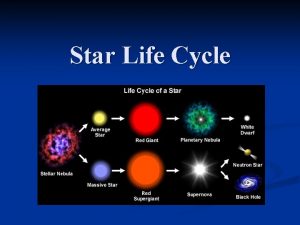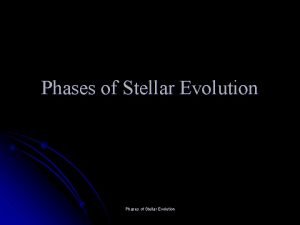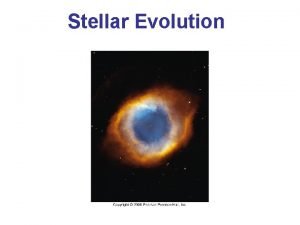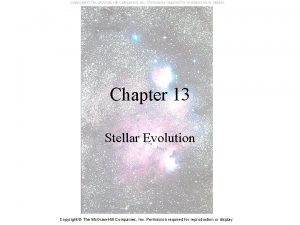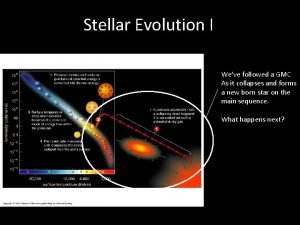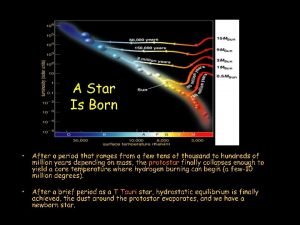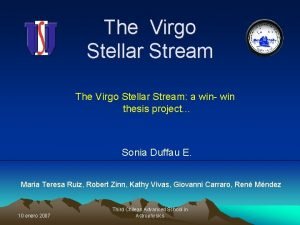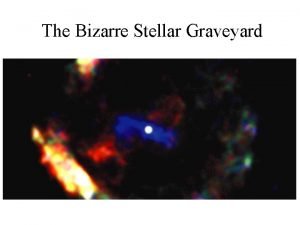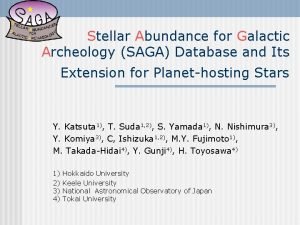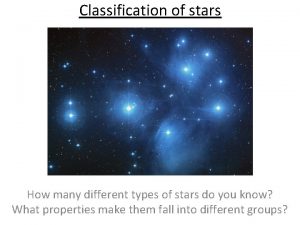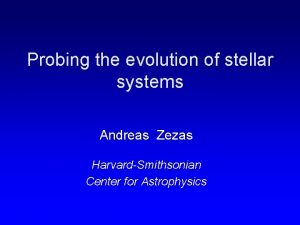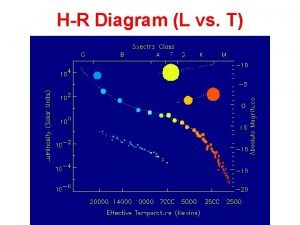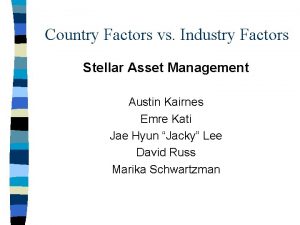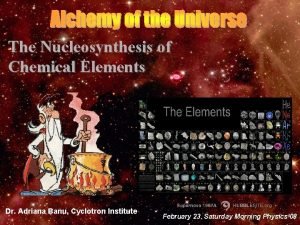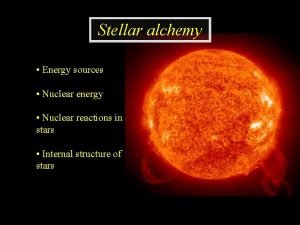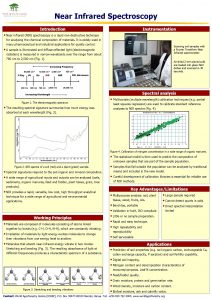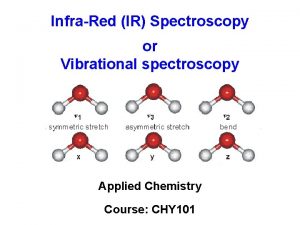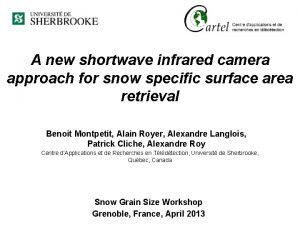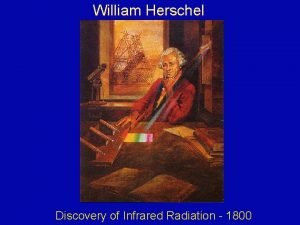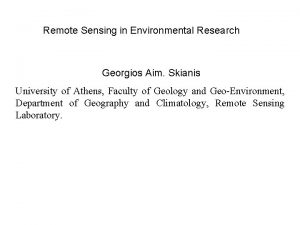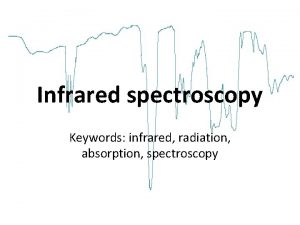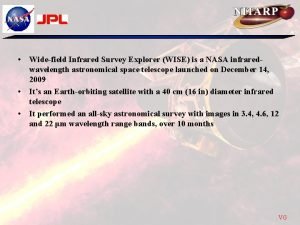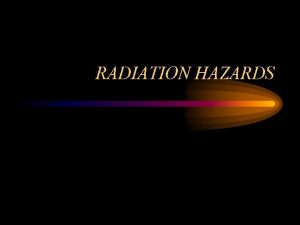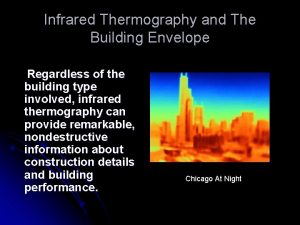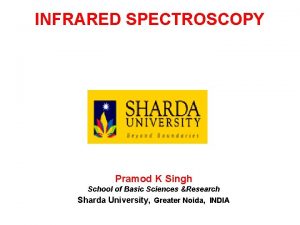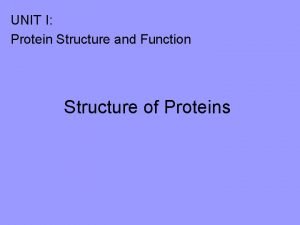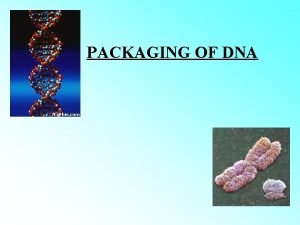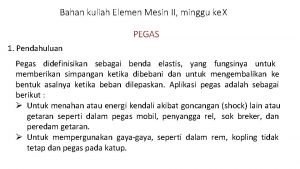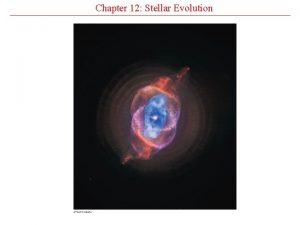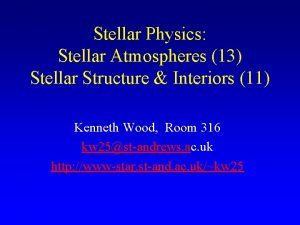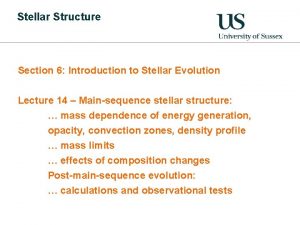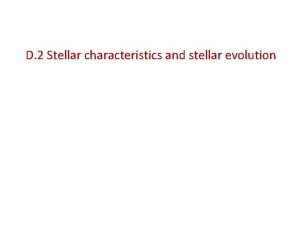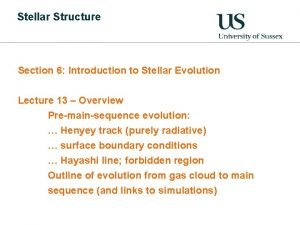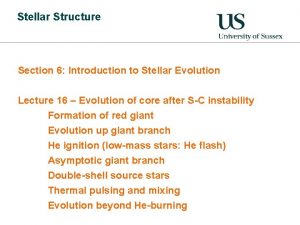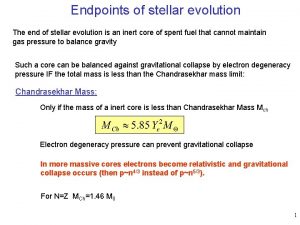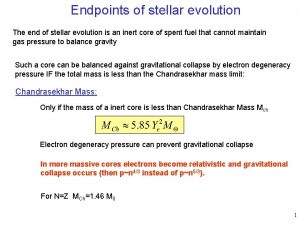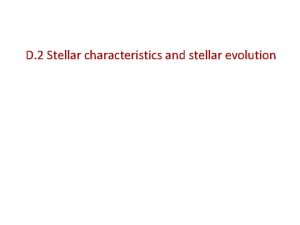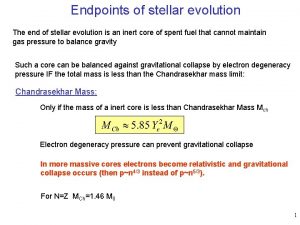Chapter 12 Stellar Evolution Infrared Image of Helix




























































- Slides: 60

Chapter 12 Stellar Evolution

Infrared Image of Helix Nebula

Mass and Stellar Fate • Low mass stars end life quietly • Massive stars end life violently • Massive - more than 8 X M

Core-hydrogen burning • Main sequence stars fuse H into He • On main sequence for over 90% of life • Hydrostatic equilibrium - pressure and gravity balance

Figure 12. 1 Hydrostatic Equilibrium

Evolution of a sun-like star • Stages 1 - 6 (pre - main sequence) • Stage 7 - main sequence • Stages 8 - 14 (post main sequence)

Stages 8 and 9 • • • Stage 8 - Subgiant branch Stage 9 - Red Giant branch H depleted at center, He core grows Core pressure decreases, gravity doesn’t He core contracts, H shell burning increases Star’s radius increases, surface cools, luminosity increases

Figure 12. 2 Solar Composition Change

Figure 12. 3 Hydrogen Shell Burning

Figure 12. 4 Red Giant on the H-R Diagram

Stage 10 - Helium Fusion • Red Giant core contracts (no nuclear burning there) • Central temperature reaches 108 K • Fusion of He starts abruptly - Helium flash for a few hours • Star re-adjusts over 100, 000 years from stage 9 to 10 • H and He burning with C core - horizontal branch

Figure 12. 5 Horizontal Branch

Figure 12. 6 Helium Shell Burning

Stage 11 - Back to Giant Branch • C core contracts (no nuclear burning there) • Gravitational heating • H and He burning increases • Radius and luminosity increases

Figure 12. 7 Reascending the Giant Branch

Table 12. 1 Evolution of a Sun-like Star

Figure 12. 8 L G-Type Star Evolution

Figure 12. 8 R G-Type Star Evolution

Death of a low mass star • For solar mass star, core temperature not high enough for C fusion • Outer layers drift away into space • Core contracts, heats up • UV radiation ionizes surrounding gas • Stage 12 - A planetary nebula • (nothing to do with planets)

Figure 12. 9 Planetary Nebulae

Other elements • As red giant dies, other elements created in core • O, Ne, Mg • Enrich interstellar medium as surface layers ejected

Dense matter • • Carbon core shrinks and stabilizes Core density 1010 kg/m 3 1000 kg in one cm 3 Pauli Exclusion Principle keeps free electrons from getting any closer together • This is a different sort of pressure

Stage 13 - White Dwarf • • • Red giant envelope recedes C core becomes visible as a white dwarf Approximately size of earth, 1/2 mass of sun White-hot surface, but dim (small size) Glow by stored heat, no nuclear reactions Fades in time to a black dwarf - stage 14

Figure 12. 10 White Dwarf on an H-R Diagram

Table 12. 2 Sirius B – A Nearby White Dwarf

Figure 12. 11 Sirius Binary System

Figure 12. 12 Distant White Dwarfs

Novae • Plural of nova • Some white dwarfs become explosively active • Rapid increase in luminosity

Figure 12. 13 ab Nova Herculis a) March 1935 b) May 1935

Figure 12. 13 c Nova

Nova explanation • White dwarf in a binary • Gravitation tears material from companion, forming accretion disk around white dwarf • Material heats until H fuses • Surface burning brief and violent • Novae can be recurrent

Figure 12. 14 Close Binary System

Figure 12. 15 Nova Matter Ejection

Evolution of High-Mass Stars • All main sequence stars move toward red-giant phase • More massive stars can fuse C and other heavier elements • Evolutionary tracks are more horizontal • 4 M star can fuse C • 15 M star can fuse C, O, Ne, Mg and become a red supergiant

Figure 12. 16 High-Mass Evolutionary Tracks

Evolution of 4 M star • • No He flash Hot enough to fuse C Can’t fuse beyond C Ends as a white dwarf

Evolution of 15 M star • • Rapid evolution Becomes red supergiant Fuses H, He, C, O, Ne, Mg, Si Inner core of iron

Figure 12. 17 Heavy-Element Fusion

Figure 12. 18 Mass Loss from Supergiants

Examples in Orion • Rigel - blue supergiant • 70 R , 50, 000 X luminosity of sun • Originally 17 M • Betelgeuse - red supergiant • 10, 000 X luminosity of sun in visible light • Originally 12 to 17 M

High mass fast evolution • • Consider 20 M star Fuses H for 10 million y Fuses He for 1 million y Fuses C for 1000 y Fuses O for one year Fuses Si for one week Fe core grows for less than a day

Death of high mass star - 1 • • • Fe fusion doesn’t produce energy Pressure decreases at core Gravitational collapse Core temperature reaches nearly 10 billion K High energy photons break nuclei into protons and neutrons - photodisintegration • Reduced pressure, accelerated collapse

Death of high mass star - 2 • • • Electrons + protons neutrons and neutrinos Density 1012 kg/m 3 Neutrinos escape, taking away energy Further collapse to 1015 kg/m 3 Neutrons packed together slow further collapse • Overshoots to 1018 kg/m 3, then rebounds • Shock wave ejects overlying material into space • Core collapse supernova

Figure 12. 19 Supernova 1987 A

Table 12. 3 End Points of Evolution for Stars of Different Masses

Novae and Supernovae • Nova - explosion on white dwarf surface in a binary system • Supernova - exploding high mass star • Million times brighter than nova • Billions of times brighter than sun • Supernova in several months radiates as much as our sun in 10 billion years

Types of Supernovae • Type I - very little H • Sharp rise in brightness, gradual fall • Type II - H rich • Plateau in light curve • Roughly half Type I and half Type II

Figure 12. 20 Supernova Light Curves

Type II Supernovae • Core collapse as previously described • Expanding layers of H and He

Type I Supernovae • Accretion disk around white dwarf can nova • Some material adds to white dwarf • Below 1. 4 M (Chandrasekhar mass), electrons support white dwarf • Above 1. 4 M , white dwarf collapses • Rapid heating, C suddenly fuses throughout • Carbon-detonation supernova • Also possible for two white dwarfs to merge

Figure 12. 21 Two Types of Supernova

Supernovae summary • Type I - carbon detonation of white dwarf exceeding 1. 4 M • Type II - core collapse of massive star, rebound and ejection of material • All high mass stars Type II supernova • Only some low mass stars Type I supernova • Low mass stars much more common than high mass • Type I and II about equally likely

Figure 12. 22 Supernova Remnants

Heavy Element Formation • All H and most He is primordial • Other elements produced through stellar evolution

Stellar evolution in star clusters • All stars the same age • Snapshot at one time

Figure 12. 23 Cluster Evolution on the H-R Diagram

Figure 12. 24 Newborn Cluster H-R Diagram

Figure 12. 25 Young Cluster H-R Diagram

Figure 12. 26 Old Cluster H-R Diagram

Figure 12. 27 Stellar Recycling
 Stellar evolution diagram
Stellar evolution diagram Zero age main sequence
Zero age main sequence Stellar evolution flow chart
Stellar evolution flow chart Stellar evolution
Stellar evolution Stellar evolution
Stellar evolution Stellar evolution
Stellar evolution Stellar evolution
Stellar evolution Stellar heaven
Stellar heaven Stellar flux
Stellar flux Stellar motion matlab
Stellar motion matlab Virgo stellar stream
Virgo stellar stream Stellar graveyard
Stellar graveyard Stellar hosting iptv
Stellar hosting iptv Stellar assessment
Stellar assessment Stellar saga
Stellar saga What is stellar parallax?
What is stellar parallax? Stellar
Stellar Stellar formation
Stellar formation Stellar asset management
Stellar asset management Stellar nucleosynthesis
Stellar nucleosynthesis Stellar wifi
Stellar wifi Stellar alchemy
Stellar alchemy Infrared vs bluetooth
Infrared vs bluetooth Infrared vs bluetooth
Infrared vs bluetooth Pengertian infrared
Pengertian infrared Near infrared spectroscopy instrumentation
Near infrared spectroscopy instrumentation Bill nye light energy
Bill nye light energy Characteristic of infrared waves
Characteristic of infrared waves Infrared spektroskopisi
Infrared spektroskopisi Ethyl benzoate ir
Ethyl benzoate ir Signage posted at a handwashing station must include
Signage posted at a handwashing station must include Shortwave infrared camera
Shortwave infrared camera Bluetooth vs infrared
Bluetooth vs infrared Future range
Future range Infrared radiation discovery
Infrared radiation discovery Infrared spectroscopy theory
Infrared spectroscopy theory Infrared spectroscopy ppt
Infrared spectroscopy ppt Thermal infrared
Thermal infrared Drainage network
Drainage network Advantage and disadvantage of touch screen
Advantage and disadvantage of touch screen National infrared operations
National infrared operations Ir spectroscopy instrumentation
Ir spectroscopy instrumentation Wide field infrared survey explorer
Wide field infrared survey explorer Em waves chart
Em waves chart Infrared radiation hazards
Infrared radiation hazards Infrared sensor principle
Infrared sensor principle Infrared building envelope
Infrared building envelope Infrared
Infrared Scott can industries
Scott can industries Super secondary structure of protein
Super secondary structure of protein Helical crus
Helical crus Coarse pitch vs. fine pitch propeller
Coarse pitch vs. fine pitch propeller Octomer
Octomer Ball sign iufd
Ball sign iufd Triangular fossa
Triangular fossa Drill drift use
Drill drift use Conveyor static analysis
Conveyor static analysis Pegas helix
Pegas helix Dna and rna coloring worksheet
Dna and rna coloring worksheet Parts of c clasp
Parts of c clasp Triple helix model
Triple helix model
